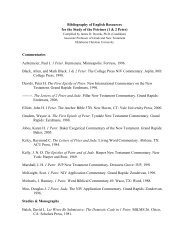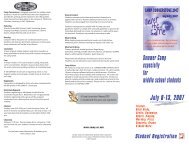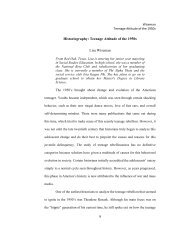the role of archeology in determining the historicity of homer's iliad
the role of archeology in determining the historicity of homer's iliad
the role of archeology in determining the historicity of homer's iliad
You also want an ePaper? Increase the reach of your titles
YUMPU automatically turns print PDFs into web optimized ePapers that Google loves.
Tau SigmaJournal <strong>of</strong> Historical StudiesSophia Schliemann, Wife <strong>of</strong> He<strong>in</strong>rich Schliemann,Wear<strong>in</strong>g Pieces from “Priam’s Treasure”122
Tau SigmaJournal <strong>of</strong> Historical Studies: Vol. XXIportrayed <strong>in</strong> <strong>the</strong> Iliad did not synchronize with <strong>the</strong>ir own view <strong>of</strong> classical Greekculture:Those myths, so <strong>the</strong> scholars believed, represented <strong>the</strong> childish stage <strong>of</strong>Hellenic culture; far more appeal<strong>in</strong>g was <strong>the</strong> image <strong>of</strong> Classical A<strong>the</strong>ns,an elegant community <strong>of</strong> philosophers, orators, and art lovers – whichwas…<strong>the</strong> way that <strong>the</strong> aristocrats and <strong>in</strong>tellectuals <strong>of</strong> Europe liked toth<strong>in</strong>k <strong>of</strong> <strong>the</strong>mselves. The violence, <strong>the</strong> plunder, and <strong>the</strong> greed <strong>of</strong> <strong>the</strong>Homeric heroes impressed <strong>the</strong> conservative classical scholars asdisturb<strong>in</strong>gly ‘un-Greek.’ So <strong>the</strong> Trojan War <strong>of</strong> <strong>the</strong> Iliad was dismissed asa fable, hav<strong>in</strong>g little basis <strong>in</strong> fact. 9This situation is a classic example <strong>of</strong> scholars who let <strong>the</strong>ir own worldview<strong>in</strong>hibit <strong>the</strong>ir research. If Greek culture did not glorify oratory skills and violenceboth, <strong>the</strong>n <strong>the</strong> Iliad, which comb<strong>in</strong>es <strong>the</strong> two, would never have been popularenough for generations to cont<strong>in</strong>ually repeat and pass <strong>the</strong> epic down throughtime. While <strong>the</strong> purpose <strong>of</strong> literary criticism was not to prove historical validity<strong>of</strong> <strong>the</strong> text, literary criticism <strong>in</strong>advertently led to <strong>the</strong> discredit<strong>in</strong>g <strong>of</strong> <strong>the</strong> Iliad asanyth<strong>in</strong>g more than poetic fiction.While literary criticism changed <strong>the</strong> way scholars viewed <strong>the</strong> Iliad,archaeology took a different approach for a different goal: prov<strong>in</strong>g <strong>the</strong> existence<strong>of</strong> Troy as a real place. Archaeology, like literary criticism, began as agentleman’s pastime, as a respectable way to earn money. But while archaeologywas motivated by <strong>the</strong> “desire to corroborate literary works… [and] <strong>the</strong> rise <strong>of</strong>neoclassicism…[it] was evolv<strong>in</strong>g from a nobleman’s hobby <strong>in</strong>to a science.” 10 Inorder to prove <strong>the</strong> <strong>historicity</strong> <strong>of</strong> Homer’s Iliad, archaeologists first had to f<strong>in</strong>d9Neil Asher Silberman, Between Past and Present: Archaeology, Ideology, andNationalism <strong>in</strong> <strong>the</strong> Modern Middle East (New York: H. Holt, 1989), 36.10 Susan Heuck Allen, F<strong>in</strong>d<strong>in</strong>g <strong>the</strong> Walls <strong>of</strong> Troy: Frank Calvert and He<strong>in</strong>richSchliemann at Hisarlík (Berkeley: University <strong>of</strong> California Press, 1999), 48-50.126
BeachArchaeology and <strong>the</strong> Iliadanalyzed modern scholarship, and <strong>the</strong>n explored <strong>the</strong> geography <strong>of</strong> <strong>the</strong> area hewas study<strong>in</strong>g to note important features, while also ask<strong>in</strong>g about locals’knowledge <strong>of</strong> sites. 30Calvert did not immediately discount P<strong>in</strong>arbasi as apossible location <strong>of</strong> Homeric Troy, and like many o<strong>the</strong>rs he believed that Clarkehad only discovered New Ilium; he did not connect New Ilium with ancientTroy. 31 Calvert actually excavated at P<strong>in</strong>arbasi first, look<strong>in</strong>g for def<strong>in</strong>itive pro<strong>of</strong>that it was <strong>the</strong> site <strong>of</strong> Homeric Troy by digg<strong>in</strong>g <strong>in</strong>to <strong>the</strong> tumulus, or burialmound, known as “<strong>the</strong> tomb <strong>of</strong> Priam.” After those excavations proved futile,however, <strong>in</strong> 1863 Calvert published his own refutation <strong>of</strong> P<strong>in</strong>arbasi. Whilelabel<strong>in</strong>g “<strong>the</strong> tomb <strong>of</strong> Hector” as “’heaps <strong>of</strong> refuse stone thrown out dur<strong>in</strong>gquarry<strong>in</strong>g,’” Calvert went a step fur<strong>the</strong>r than his contemporaries by provid<strong>in</strong>g analternative identification for <strong>the</strong> ru<strong>in</strong>s at P<strong>in</strong>arbasi: Gergis, “a town settled byTrojans who had emigrated to Cyprus and had returned ‘to colonize <strong>the</strong>ir ancientfa<strong>the</strong>rland.’” 32 Calvert may have been <strong>in</strong>fluenced by a family friend and scholar,Charles Maclaren, who believed New Ilium was built on ancient Troy, becausehe <strong>the</strong>n began his study <strong>of</strong> Hisarlík, <strong>the</strong> eastern half <strong>of</strong> which his family had justpurchased, along with some <strong>of</strong> <strong>the</strong> surround<strong>in</strong>g fields. 33 Unfortunately, around<strong>the</strong> same time that Frank Calvert was prepar<strong>in</strong>g to excavate Hisarlík, his olderbro<strong>the</strong>r Frederick was caught up <strong>in</strong> a well-publicized political scandal; not onlydid Frank now lose <strong>the</strong> family funds support<strong>in</strong>g his research, but he also lost30 Allen, 64.31Ibid., 73-75.32 Ibid., 81-83.33 Ibid., 75.133
Tau SigmaJournal <strong>of</strong> Historical Studies: Vol. XXIsupport among his peers. 34It was at this po<strong>in</strong>t that Calvert met He<strong>in</strong>richSchliemann, a self-made millionaire eager to <strong>in</strong>crease his own social prestigethrough <strong>the</strong> gentleman’s hobby <strong>of</strong> archaeology.Calvert may have only <strong>in</strong>tended a f<strong>in</strong>ancial partnership, but a verydifferent relationship developed. Regardless <strong>of</strong> what Calvert had planned when<strong>in</strong>troduc<strong>in</strong>g Schliemann to his new hypo<strong>the</strong>sis, that Hisarlík was <strong>the</strong> site <strong>of</strong> fabledTroy, Schliemann took <strong>the</strong> task <strong>of</strong> excavat<strong>in</strong>g <strong>the</strong> site upon himself and quicklymade it <strong>in</strong>to his own personal quest. Accord<strong>in</strong>g to Allen, “Schliemann’s efforts tom<strong>in</strong>imize Calvert’s <strong>role</strong> <strong>in</strong> <strong>the</strong> discovery <strong>of</strong> Troy <strong>in</strong> order to maximize his own[prestige] began immediately after <strong>the</strong>ir first meet<strong>in</strong>g,” <strong>in</strong> August <strong>of</strong> 1868. Allenalso states that Schliemann “back-dated not only <strong>the</strong> diary entries, but also aletter to his fa<strong>the</strong>r from P<strong>in</strong>arbasi…and <strong>the</strong> letter he wrote to his sister andbro<strong>the</strong>r-<strong>in</strong>-law…conveniently omit[t<strong>in</strong>g] any mention <strong>of</strong> Calvert.” 35Allensuggests that Schliemann may not have slighted Calvert out <strong>of</strong> malicious <strong>in</strong>tent,but that, most likely, he wanted to distance himself from <strong>the</strong> Calvert family; hewanted to <strong>in</strong>crease his social prestige among o<strong>the</strong>r n<strong>in</strong>eteenth century Europeans,and <strong>the</strong> Calverts were now <strong>in</strong> a very precarious position, due to politicalscandals. 36 Yet <strong>the</strong> truth <strong>of</strong> <strong>the</strong> matter is that Schliemann’s claim that his lifelongdream was to f<strong>in</strong>d and excavate Homer’s Troy was a fabrication. Schliemannnever mentioned this goal <strong>in</strong> any <strong>of</strong> his diaries until after his meet<strong>in</strong>g with34 Allen, 85.35 Ibid., 120-121.36 Ibid., 121.134
BeachArchaeology and <strong>the</strong> IliadCalvert that year, and it is apparent from his correspondence with Calvert that heknew noth<strong>in</strong>g about Hisarlík except what Calvert told him. 37Not only did he not know about Hisarlík, Schliemann also knew noth<strong>in</strong>gabout archaeological techniques or methods, and Schliemann’s <strong>in</strong>experience wasevident <strong>in</strong> his excavation methods. De Camp states that if Schliemann belongedto any particular school <strong>of</strong> archaeology, he “belonged to <strong>the</strong> ruthless school. AtTroy he drove a huge trench <strong>in</strong>to <strong>the</strong> nor<strong>the</strong>rn side <strong>of</strong> Hisarlík. This trench,toge<strong>the</strong>r with his o<strong>the</strong>r digg<strong>in</strong>gs, removed half <strong>the</strong> hill.” 38 Among <strong>the</strong> normalexcavation equipment, Schliemann also used “batter<strong>in</strong>g rams, as well as screwjacks,cha<strong>in</strong>s, and w<strong>in</strong>dlass.” 39 Schliemann <strong>of</strong>ten wrote about <strong>the</strong> dangers <strong>of</strong> <strong>the</strong>excavations, apparently not realiz<strong>in</strong>g that his rough, impatient methods were <strong>the</strong>root cause. On August 14, 1872, Schliemann wrote, “In spite <strong>of</strong> every precaution,excavations <strong>in</strong> which men have to work under ear<strong>the</strong>n walls <strong>of</strong> above 50 feet <strong>in</strong>perpendicular depth are always very dangerous…Many stones roll down <strong>the</strong>steep walls without <strong>the</strong> workmen notic<strong>in</strong>g <strong>the</strong>m.” 40 Cave-<strong>in</strong>s and rocks slidesseem to have been very common. Earlier that year, Schliemann wrote, “In spite<strong>of</strong> every precaution, however, I am unable to guard my men or myself aga<strong>in</strong>st <strong>the</strong>stones which cont<strong>in</strong>ually come roll<strong>in</strong>g down, when <strong>the</strong> steep wall is be<strong>in</strong>g picked37 Curtis Runnels, The Archaeology <strong>of</strong> He<strong>in</strong>rich Schliemann: An AnnotatedBibliographic Handlist (Boston: Archaeological Institute <strong>of</strong> America, 2002), 22-23;Allen, 119.38 De Camp, 81.39 Leo Deuel and He<strong>in</strong>rich Schliemann, Memoirs <strong>of</strong> He<strong>in</strong>rich Schliemann: ADocumentary Portrait Drawn from His Autobiographical Writ<strong>in</strong>gs, Letters, andExcavation Reports (New York: Harper & Row, 1977), 169.40 Ibid.,184.135
Tau SigmaJournal <strong>of</strong> Historical Studies: Vol. XXIaway. Not one <strong>of</strong> us is without several wounds <strong>in</strong> his feet.” 41 But Schliemann’smethods, while rough and dangerous, did produce results. In 1882, Schliemanndiscovered <strong>the</strong> hot and cold spr<strong>in</strong>gs “<strong>in</strong> a very ancient rock channel at <strong>the</strong> foot <strong>of</strong>Hisarlík, near to <strong>the</strong> gate which may fairly be identified with <strong>the</strong> Skaian.” 42 Thus,Hisarlík was now def<strong>in</strong>itively identified not only as Ilium Novum, but also asancient Troy. Never<strong>the</strong>less, Schliemann’s most famous discovery was not <strong>the</strong><strong>in</strong>famous hot and cold spr<strong>in</strong>gs. Ra<strong>the</strong>r it was what he later called “Priam’sTreasure.”The story <strong>of</strong> how Schliemann discovered <strong>the</strong> treasure is well known;while excavat<strong>in</strong>g, he saw someth<strong>in</strong>g metallic, and after realiz<strong>in</strong>g that what he sawwas gold, he immediately had his wife dismiss <strong>the</strong> workers. They were <strong>the</strong>n ableto sneak <strong>the</strong> treasure out <strong>of</strong> <strong>the</strong> site by hid<strong>in</strong>g <strong>the</strong> various items <strong>in</strong> Mrs.Schliemann’s shawl. Schliemann recorded <strong>the</strong> event <strong>in</strong> his diary, writ<strong>in</strong>g:In excavat<strong>in</strong>g [a] wall fur<strong>the</strong>r and directly by <strong>the</strong> side <strong>of</strong> <strong>the</strong> Palace <strong>of</strong>K<strong>in</strong>g Priam, I came upon a large copper article <strong>of</strong> <strong>the</strong> most remarkableform, which attracted my attention all <strong>the</strong> more as I thought I saw goldbeh<strong>in</strong>d it…In order to withdraw <strong>the</strong> treasure from <strong>the</strong> greed <strong>of</strong> myworkmen, and to save it for archaeology, I had to be most expeditious,and although it was not yet time for breakfast, I immediately had‘païdos’ [time for rest] called. 43Schliemann claimed <strong>the</strong> f<strong>in</strong>d as <strong>the</strong> “treasure <strong>of</strong> Priam,” say<strong>in</strong>g:As I found all <strong>the</strong>se articles toge<strong>the</strong>r, form<strong>in</strong>g a rectangular mass, orpacked <strong>in</strong>to one ano<strong>the</strong>r, it seems to be certa<strong>in</strong> that <strong>the</strong>y were placed on<strong>the</strong> city wall <strong>in</strong> a wooden chest…such as those mentioned by Homer asbe<strong>in</strong>g <strong>in</strong> <strong>the</strong> palace <strong>of</strong> K<strong>in</strong>g Priam. This appears to be <strong>the</strong> more certa<strong>in</strong>, as41Deuel and Schliemann, 180.42 Schuchhardt and Strong, 25.43 Deuel and Schliemann, 205.136
BeachArchaeology and <strong>the</strong> Iliadclose by <strong>the</strong> side <strong>of</strong> <strong>the</strong>se articles I found a copper key above 4 <strong>in</strong>cheslong, <strong>the</strong> head <strong>of</strong> which…greatly resembles a large safe-key <strong>of</strong> a bank. 44For Schliemann, who dug down to <strong>the</strong> very bottom <strong>of</strong> <strong>the</strong> tel, this treasure waspro<strong>of</strong> that <strong>the</strong> stratum later designated as Troy II was <strong>in</strong>deed Homeric Troy.Fur<strong>the</strong>r pro<strong>of</strong> came from evidence that <strong>the</strong> Troy II was “suddenly…stormed anddestroyed by <strong>the</strong> enemy,” which was proved by “<strong>the</strong> skeletons <strong>of</strong> men with arms,and by <strong>the</strong> f<strong>in</strong>d<strong>in</strong>g <strong>of</strong> <strong>in</strong>numerable hand-made terracotta vases, with splendidly<strong>in</strong>cised whorls.” 45 Homer’s work <strong>in</strong>spired Schliemann’s “overall excavation plan,which…rested on two assumptions derived from <strong>the</strong> Iliad, namely that <strong>the</strong> temple<strong>of</strong> <strong>the</strong> Trojan Pallas A<strong>the</strong>ne occupied <strong>the</strong> highest po<strong>in</strong>t <strong>of</strong> <strong>the</strong> hill, while <strong>the</strong>defense wall with Priam’s citadel…had to be at <strong>the</strong> very bottom.” 46WhenSchliemann smuggled <strong>the</strong> treasure to Greece, however, <strong>the</strong> Turkish governmentsued him and revoked his firman, or digg<strong>in</strong>g permit. 47After three years <strong>of</strong>excavat<strong>in</strong>g Hisarlík (approximately 1871 to 1874), Schliemann was <strong>the</strong>n forcedto excavate elsewhere.After two years <strong>of</strong> litigation, which ended when Schliemann paid a heftyf<strong>in</strong>e to <strong>the</strong> Turkish government, <strong>the</strong> Turkish government lifted <strong>the</strong> ban onSchliemann and he returned to <strong>the</strong> site. When Schliemann resumed excavationsat Hisarlík, he brought an assistant, William Dörpfeld, who was an architect bytrade and also an experienced archaeologist. Dörpfeld remapped Schliemann’s44 Deuel and Schliemann, 207.45 Bacon, 73.46 Deuel and Schliemann, 166-167.47 John and Elizabeth Romer, The History <strong>of</strong> Archaeology (New York: CheckmarkBooks, 2001), 110.137
Tau SigmaJournal <strong>of</strong> Historical Studies: Vol. XXIseven cities <strong>in</strong>to n<strong>in</strong>e different cities <strong>in</strong> <strong>the</strong> strata at Hisarlík, <strong>the</strong> second <strong>of</strong> which,henceforth known as Troy II, Schliemann claimed as Homeric Troy. 48Eventhough he cont<strong>in</strong>ued claim<strong>in</strong>g Troy II as Homeric Troy, Schliemann begandoubt<strong>in</strong>g his own conclusion. Dur<strong>in</strong>g his ban from excavat<strong>in</strong>g Hisarlík,Schliemann dug at <strong>the</strong> Greek sites Mycenae and Ithaca, but found no culturalrema<strong>in</strong>s similar to those found at Hisarlík; no similarities or connections seemedto exist between <strong>the</strong> two civilizations. 49 Later that year, however, Schliemannuncovered “two large rectangular rooms <strong>of</strong> stone and some brokenpotsherds…different from anyth<strong>in</strong>g else that he had found at Troy; but he knew<strong>the</strong> type well, from many Greek sites he had excavated.” 50 This type <strong>of</strong> pottery,which modern scholars call Gray M<strong>in</strong>yan Ware, did not exist <strong>in</strong> <strong>the</strong> same stratum<strong>of</strong> Troy II, but <strong>in</strong> Dörpfeld’s sixth city, Troy VI. 51Dörpfeld believed Troy VIwas <strong>the</strong> true Homeric Troy, and shortly before his death, Schliemann admittedthat his orig<strong>in</strong>al conclusions might have been too hasty, tell<strong>in</strong>g Dörpfeld beforeleav<strong>in</strong>g Hisarlík for <strong>the</strong> last time that he “had been mistaken <strong>in</strong> his identification<strong>of</strong> Homer’s city.” 52 Schliemann died a few months later, however, and thus neverhad a chance to study Troy VI.After Schliemann’s death, his widow hired Dörpfeld to cont<strong>in</strong>ue <strong>the</strong>excavations. Despite Schliemann destroy<strong>in</strong>g much <strong>of</strong> Troy VI and subsequent48 Romer, 118.49 Ibid.50 Ibid.51 De Camp, 83.52 Romer, 119.138
BeachArchaeology and <strong>the</strong> Iliadlayers <strong>in</strong> his dig to Troy II, enough <strong>of</strong> <strong>the</strong> site rema<strong>in</strong>ed <strong>in</strong>tact for Dörpfeld tocont<strong>in</strong>ue excavations and form his own conclusions. Besides <strong>the</strong> discovery <strong>of</strong>Grey M<strong>in</strong>yan Ware <strong>in</strong> <strong>the</strong> level <strong>of</strong> Troy VI, Dörpfeld also supported his claimthat Homer’s Troy was Troy VI based on <strong>the</strong> massive fortified walls and <strong>the</strong>terraced layout <strong>of</strong> <strong>the</strong> citadel. 53 Accord<strong>in</strong>g to Dörpfeld, this sort <strong>of</strong> constructionwas what Homer had described <strong>in</strong> <strong>the</strong> Iliad. Dörpfeld also concluded that <strong>the</strong>houses <strong>in</strong> Troy VI were just like <strong>the</strong> house <strong>of</strong> Paris, or Alexandros, as Homerdescribed. These houses conta<strong>in</strong>ed three dist<strong>in</strong>ct rooms: a courtyard, receptionroom, and liv<strong>in</strong>g quarters. 54 Like Schliemann’s Troy II, Dörpfeld claimed, TroyVI showed “traces <strong>of</strong> an extensive conflagration.” 55 Dörpfeld published his work<strong>in</strong> 1890 before go<strong>in</strong>g on to work at o<strong>the</strong>r Mediterranean sites.An excavation team from <strong>the</strong> University <strong>of</strong> C<strong>in</strong>c<strong>in</strong>nati, led by CarlBlegen, resumed work at Hisarlík <strong>in</strong> 1932, about forty years after Dörpfeldf<strong>in</strong>ished his excavations. S<strong>in</strong>ce Dörpfeld and Schliemann’s excavations, <strong>the</strong> sitehad fallen <strong>in</strong>to fur<strong>the</strong>r disrepair due general neglect and damages from WorldWar I. The C<strong>in</strong>c<strong>in</strong>nati team “did not do much drastic excavation, but <strong>the</strong>ycleaned up <strong>the</strong> older digg<strong>in</strong>gs and m<strong>in</strong>utely studied <strong>the</strong>ir stratigraphy.” 56 Evenwith such damage, Blegen and his team concluded that <strong>the</strong> damage <strong>of</strong> Troy VI’swalls resulted from an earthquake, because <strong>the</strong> “jagged cracks <strong>in</strong> some <strong>of</strong> this53 Herbert Cush<strong>in</strong>g Tolman and Gilbert Campbell Scogg<strong>in</strong>, Mycenaean Troy (NewYork: American Book Company, 1903), 38. The wall was fifteen to twenty feet high andmeasured about sixteen feet thick.54 Ibid., 41.55 Ibid., 85.56 De Camp, 83.139
Tau SigmaJournal <strong>of</strong> Historical Studies: Vol. XXIcity’s massive towers and <strong>the</strong> precarious, backward tilt <strong>of</strong> a section <strong>of</strong> <strong>the</strong> citadelwalled seemed…beyond <strong>the</strong> power <strong>of</strong> an <strong>in</strong>vasion force armed ma<strong>in</strong>ly withbronze spears and swords.” 57Blegen himself wrote:The debris seems far too extensive to have been pitched over wantonlyby <strong>the</strong> hand <strong>of</strong> man, and, consider<strong>in</strong>g o<strong>the</strong>r supplementary evidence, wemay safely conclude that <strong>the</strong> end <strong>of</strong> Troy VI was brought about by asevere earthquake, which rendered <strong>the</strong> houses un<strong>in</strong>habitable and causedserious damage to <strong>the</strong> superstructure <strong>of</strong> <strong>the</strong> fortress itself. 58Blegen’s new <strong>the</strong>ory stated that Homer’s Troy was Troy VIIa, <strong>the</strong> earliestdist<strong>in</strong>guishable layer <strong>of</strong> <strong>the</strong> seventh city. Blegen based his <strong>the</strong>ory on two ideas.The first was that, while smaller, <strong>the</strong> city <strong>of</strong> Troy VIIa conta<strong>in</strong>ed “tightly packedhouses along <strong>the</strong> <strong>in</strong>side <strong>of</strong> <strong>the</strong> fortification walls,” which suggested “<strong>the</strong> presence<strong>of</strong> a much larger population seek<strong>in</strong>g shelter, and <strong>in</strong> many <strong>of</strong> <strong>the</strong> modest houses <strong>of</strong>this stratum were an unusually large number <strong>of</strong> storejars and silos – apparentlyfor emergency supplies.” 59 These storejars, Blegen said, were evidence that asiege had taken place, and <strong>the</strong> people tried to store as many supplies as possible.However, <strong>the</strong> pottery Blegen’s team found <strong>in</strong> Troy VIIa held more significancethan as simple evidence <strong>of</strong> a siege; <strong>the</strong> pottery <strong>of</strong> Troy VIIa was a fullydeveloped style, whereas <strong>the</strong> pottery <strong>of</strong> Troy VI was not. Blegen believed that“<strong>the</strong> Trojan War took place at <strong>the</strong> height <strong>of</strong> Mycenaean power… [and] it seemedsignificant to him that Troy VIIa conta<strong>in</strong>ed examples <strong>of</strong> pottery <strong>of</strong> <strong>the</strong> fully57 Silberman, 44-45.58 Carl W. Blegen, “The Pr<strong>in</strong>cipal Homeric Sites: Troy,” <strong>in</strong> A Companion to Homer,ed. Alan J.B. Wace and Frank H. Stubb<strong>in</strong>gs (UK: The Macmillan Company, 1969), 375.59 Ibid., 379.140
BeachArchaeology and <strong>the</strong> Iliaddeveloped Late Bronze Age Mycenaean style.” 60The second claim thatsupported Blegen’s hypo<strong>the</strong>sis was that, while an earthquake had destroyed TroyVI, Troy VII showed clear signs <strong>of</strong> destruction by fire. Blegen wrote, “The state<strong>of</strong> <strong>the</strong> ru<strong>in</strong>s <strong>in</strong>dicates that <strong>the</strong> whole citadel, after a relatively short existence, was<strong>in</strong> fact destroyed by a devastat<strong>in</strong>g fire, with suggestions <strong>of</strong> accompany<strong>in</strong>gviolence (human bones lay unburied <strong>in</strong> <strong>the</strong> streets just <strong>in</strong>side <strong>the</strong> South Gate andwere also found <strong>in</strong> two houses).” 61While Troy VI may have been moreprosperous and longer-lived than Troy VIIa, Blegen argued that evidence did notsupport its destruction by siege; <strong>the</strong>refore it was impossible that Troy VI wasHomeric Troy. Ra<strong>the</strong>r, Blegen po<strong>in</strong>ted to <strong>the</strong> unburied rema<strong>in</strong>s <strong>of</strong> Troy VIIa’scitizens and its destruction by fire as evidence that, though smaller than Troy VI,Troy VIIa was Homeric Troy.The C<strong>in</strong>c<strong>in</strong>nati excavations ended <strong>in</strong> 1938, after only six years <strong>of</strong>excavations, and it was ano<strong>the</strong>r forty or fifty years before Troy entered <strong>the</strong>spotlight aga<strong>in</strong>, when Michael Wood, an English historian and broadcaster for<strong>the</strong> BBC, made a documentary about <strong>the</strong> excavations at Troy. Just as potteryanalysis had advanced <strong>in</strong> <strong>the</strong> time between Dörpfeld and Blegen, it advancedfur<strong>the</strong>r <strong>in</strong> <strong>the</strong> latter half <strong>of</strong> <strong>the</strong> twentieth century. S<strong>in</strong>ce Blegen’s excavations,fur<strong>the</strong>r analysis <strong>of</strong> <strong>the</strong> pottery found at Hisarlík showed that “Troy VIIaconta<strong>in</strong>ed some pottery types that postdated <strong>the</strong> destruction <strong>of</strong> <strong>the</strong> Mycenaean60 Silberman, 45.61 Blegen, 379.141
Tau SigmaJournal <strong>of</strong> Historical Studies: Vol. XXIpalaces <strong>in</strong> Greece.” 62 This meant that Blegen’s hypo<strong>the</strong>sis, which was based on<strong>the</strong> idea that Troy VIIa would have fully developed Mycenaean pottery, nolonger fit, because Troy VIIa had pottery that appeared after <strong>the</strong> fall <strong>of</strong> <strong>the</strong>Mycenaean civilization. Wood supported his claims with evidence that Troy VIactually showed signs <strong>of</strong> destruction by fire, after all, while also hypo<strong>the</strong>siz<strong>in</strong>gthat an earthquake certa<strong>in</strong>ly would have helped any <strong>in</strong>vaders attack<strong>in</strong>g Troy VI. 63It is clear, however, that Wood did not support <strong>the</strong> hypo<strong>the</strong>sis <strong>of</strong> Troy VI’s ru<strong>in</strong>via earthquake. Wood argued that men could have destroyed <strong>the</strong> walls <strong>of</strong> TroyVI, po<strong>in</strong>t<strong>in</strong>g to Euripides’ Trojan Women, <strong>in</strong> which <strong>the</strong> Achaean’s demolition <strong>of</strong>Troy’s towers is described as an earthquake. 64 Wood stated:They [siege eng<strong>in</strong>es] certa<strong>in</strong>ly existed <strong>in</strong> Near Eastern warfare at thistime: powerful ‘wooden horses’ conta<strong>in</strong><strong>in</strong>g many men to operate <strong>the</strong>ram, which opened city walls, <strong>the</strong>y were developed most effectively <strong>in</strong>Assyria from <strong>the</strong> twelfth century B.C. onwards, but we have no<strong>in</strong>dication that such devices were used <strong>in</strong> thirteenth century Aegean. 65Wood admits his <strong>the</strong>ory was <strong>in</strong>conclusive, but <strong>in</strong>sists it rema<strong>in</strong> a possibility,because <strong>the</strong> earthquake damage was not enough to completely ru<strong>in</strong> <strong>the</strong> walls andmake <strong>the</strong>m wholly useless.Fur<strong>the</strong>rmore, Wood argued, Blegen had made a false assumption bylett<strong>in</strong>g his experiences dur<strong>in</strong>g World War I <strong>in</strong>terfere with his <strong>in</strong>terpretation <strong>of</strong> <strong>the</strong>evidence, hav<strong>in</strong>g “<strong>in</strong>ferred a war economy like <strong>the</strong> soup kitchens dur<strong>in</strong>g <strong>the</strong> Blitz62 Silberman, 46.63 Michael Wood, In Search <strong>of</strong> <strong>the</strong> Trojan War (Berkeley: University <strong>of</strong> CaliforniaPress, 1985), 22.64 Euripides, Trojan Women, trans. Alan Shapiro (New York: Oxford UniversityPress, 2009), 77-78.65 Wood, 77-78.142
BeachArchaeology and <strong>the</strong> Iliad<strong>of</strong> London, <strong>the</strong> images <strong>of</strong> his own day.” 66 However, Silberman critiques Wood’sown <strong>the</strong>ories about <strong>the</strong> motivation for <strong>the</strong> Trojan war, say<strong>in</strong>g that both <strong>of</strong> Wood’shypo<strong>the</strong>ses were colored by modern events: “Wood’s ‘Plausible Hypo<strong>the</strong>sis No.1’ suggested that <strong>the</strong> sack <strong>of</strong> Troy may have come as <strong>the</strong> result <strong>of</strong> imperialisticaggression <strong>of</strong> an om<strong>in</strong>ously modern k<strong>in</strong>d…’Plausible Hypo<strong>the</strong>sis No. 2’suggested an equally modern situation: a superpower conflict between <strong>the</strong>Mycenaeans and <strong>the</strong> Hittites <strong>of</strong> Asia M<strong>in</strong>or.” 67Wood’s own objectivity isquestionable, but many scholars have provided similar explanations for why <strong>the</strong>Trojan War occurred. Ano<strong>the</strong>r scholar, Walter Leaf, believed that “Helen was <strong>the</strong>excuse, but <strong>the</strong> real objective was <strong>the</strong> control <strong>of</strong> <strong>the</strong> land and sea trade-routeswhich converged on Troy.” 68 Leaf <strong>the</strong>orized that sea currents forced ships to landat Troy, where <strong>the</strong> k<strong>in</strong>g forced <strong>the</strong>m to pay tribute and sell <strong>the</strong>ir goods, whichexpla<strong>in</strong>s Troy’s wealth despite <strong>the</strong> unfriendly geographical location. O<strong>the</strong>rscholars believe that <strong>the</strong>re was no trade at this time, and that <strong>the</strong> Trojans andGreeks <strong>of</strong> this period were more <strong>in</strong>terested <strong>in</strong> fight<strong>in</strong>g. One such scholar isThomas W. Allen, who argued <strong>the</strong> Achaeans wanted to “remove <strong>the</strong> last powerwhich dom<strong>in</strong>ated <strong>the</strong> Asiatic coast and prevented settlement.” 69 The problemwith this <strong>the</strong>ory, however, is that <strong>the</strong> location <strong>of</strong> Troy is not a very hospitableregion, and <strong>the</strong>re is very little to make it a candidate for colonization. Nor do any<strong>of</strong> <strong>the</strong> <strong>the</strong>ories about Achaean motivation connect any <strong>of</strong> <strong>the</strong> layers <strong>of</strong> Hisarlík to66 Silberman, 46.67 Ibid.68 Bowra, 180.69 Ibid., 181.143
Tau SigmaJournal <strong>of</strong> Historical Studies: Vol. XXI<strong>the</strong> Troy <strong>of</strong> Homer.Part <strong>of</strong> <strong>the</strong> problem with determ<strong>in</strong><strong>in</strong>g which Troy is Homeric Troy is <strong>the</strong>lack <strong>of</strong> accuracy <strong>in</strong> dat<strong>in</strong>g methods and <strong>of</strong> material evidence to test. The potterythat Schliemann found <strong>in</strong> his last dig season cannot be analyzed due to anunfortunate <strong>in</strong>cident. Dur<strong>in</strong>g World War I <strong>the</strong> pottery was stored <strong>in</strong> a castle <strong>in</strong>Prussia for protection. De Camp writes:Now, a qua<strong>in</strong>t peasant custom <strong>in</strong> those parts is <strong>the</strong> Polterabend, whenmen assemble <strong>of</strong> an even<strong>in</strong>g to get soused on beer and to break a lot <strong>of</strong>cheap crockery by throw<strong>in</strong>g it aga<strong>in</strong>st a wall. Some <strong>of</strong> <strong>the</strong> natives wanteda Polterabend because one <strong>of</strong> <strong>the</strong>m was gett<strong>in</strong>g married. But <strong>the</strong>re was nospare crockery, cheap or o<strong>the</strong>rwise, to be had until somebodyremembered <strong>the</strong> crates <strong>in</strong> <strong>the</strong> castle…So drunken peasants smashed tosmi<strong>the</strong>reens every last piece <strong>of</strong> <strong>the</strong> collection <strong>of</strong> Trojan pottery. 70Thus <strong>the</strong> story <strong>of</strong> modern excavations and <strong>in</strong>vestigations at Troy seems tocont<strong>in</strong>ue <strong>the</strong> same tragic narrative <strong>of</strong> Homer’s Iliad. There is no way to compare<strong>the</strong> pottery Schliemann and Dörpfeld found with <strong>the</strong> pottery from <strong>the</strong> C<strong>in</strong>c<strong>in</strong>natiexcavations, complicat<strong>in</strong>g <strong>the</strong> dat<strong>in</strong>g <strong>of</strong> Troy. However, based on o<strong>the</strong>r evidencefound at Hisarlík, archaeologists have at least been able to date <strong>the</strong> differentcities, plac<strong>in</strong>g Troy VI from about 1280-1240 B.C. and Troy VII from 1220-1180B.C. 71 Bowra places <strong>the</strong> end <strong>of</strong> <strong>the</strong> Heroic Age, which, accord<strong>in</strong>g to ancientsources, ended after <strong>the</strong> Siege <strong>of</strong> Troy and with <strong>the</strong> return <strong>of</strong> <strong>the</strong> Heraclids, orDoric <strong>in</strong>vasion, <strong>in</strong> <strong>the</strong> twelfth century B.C. 72 Thus <strong>the</strong> Heroic Age encompasses70 De Camp, 82.71 Raaflaub, 386. For reference, Mycenaean culture is dated from about 1600 to 1200B.C., so both <strong>of</strong> <strong>the</strong>se cities would have existed at <strong>the</strong> same time as Mycenae.72Bowra, 169-170. Bowra bases his dates <strong>of</strong>f <strong>of</strong> Greek genealogical records,allow<strong>in</strong>g for forty years per generation, with <strong>the</strong> Heroic Age last<strong>in</strong>g about five to sixgenerations.144
BeachArchaeology and <strong>the</strong> Iliad<strong>the</strong> destruction <strong>of</strong> both Troy VI and VIIa. The genealogies cannot rule out ei<strong>the</strong>rcity, and <strong>the</strong>re is no material evidence to clearly show favor <strong>of</strong> one city over <strong>the</strong>o<strong>the</strong>r. Fur<strong>the</strong>rmore, although o<strong>the</strong>r material rema<strong>in</strong>s from <strong>the</strong> site can helpestablish a rough date, not enough evidence exists to establish a concrete date,because dur<strong>in</strong>g his own excavations, Schliemann destroyed everyth<strong>in</strong>g <strong>in</strong> his pathand made no records <strong>of</strong> <strong>the</strong> layers he dug through on his way down to Troy II.While most scholars agree that <strong>the</strong> site <strong>of</strong> Hisarlík is Troy, <strong>the</strong>re is stillno def<strong>in</strong>itive evidence l<strong>in</strong>k<strong>in</strong>g any one city to <strong>the</strong> city described <strong>in</strong> Homer’s Iliad.Because <strong>of</strong> Schliemann’s rough methods, def<strong>in</strong>itive pro<strong>of</strong> may never be found,because his excavations destroyed much <strong>of</strong> <strong>the</strong> middle strata <strong>of</strong> <strong>the</strong> tel.Schliemann’s character, too, has been called <strong>in</strong>to question, and if not for <strong>the</strong> work<strong>of</strong> scholars after him, such as Dörpfeld and Blegen, all <strong>of</strong> his research might bediscredited. Instead, Dörpfeld and Blegen’s revisionist approach and publicationshelped to justify Schliemann’s work, because <strong>the</strong>y worked from <strong>the</strong> basisSchliemann’s excavations provided. Despite <strong>the</strong> <strong>in</strong>creased knowledge providedby subsequent archaeologists who followed Schliemann, because <strong>of</strong> <strong>the</strong>destruction and deterioration <strong>of</strong> <strong>the</strong> site, both from time and Schliemann’shaphazard methods, def<strong>in</strong>itive pro<strong>of</strong> <strong>of</strong> <strong>the</strong> Trojan peoples’ existence will mostlikely come from Hittite texts, similar to how Achaeans have been discoveredand proven <strong>in</strong> Hittite correspondence.145
















